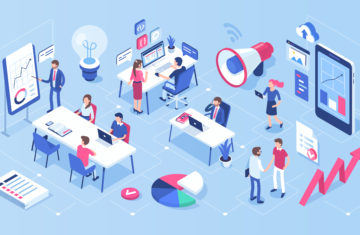All teams crave growth. Marcus has his eyes set on a promotion, Kayla is interested in transferring to another department, and Zhu just wants to learn new skills. This is true of your team as well. Be certain –even if they have never mentioned it– that your employees are already thinking about their next step, and that they are looking up to you to provide them not only with their next opportunity, but to support them with the right tools and coaching.
By making your learning management system the backbone of your team’s development plan, you can help your employees achieve their career objectives, while increasing their overall happiness, productivity, and retention.
Here are some steps you can take to create a robust employee career plan, and encourage a culture of learning and growth using your LMS.
1. Ensure a career plan is in place
Many companies struggle to create well-defined career ladders because, let’s admit it, we often hire as we need. But if you are a CEO or HR manager, creating a vision about what a future organizational chart could look like, can be key to retaining your employees –especially those important first hires.
If you don’t know where to start, take a look at other companies in your industry, and make a draft of your possible org chart and future job descriptions. Be clear about the roles that will make or break your business –those the company can’t live without, and build possible career pathways.
For example, if you know that you need a graphic designer, keep in mind current lines of progression such as lead, senior, and director roles. You may recruit for these roles outside the company, but knowing the requirements, skills and experiences that differentiate each role, can help you identify training opportunities. This can also help you draft a potential content map for your LMS.
2. Develop your training plan
Now that you know what skills your team need to have to move to their next role, it’s time to develop a training plan. Map the required skills for each role, and connect these with specific career objectives while setting timelines or milestones.
For example, if your sales manager were to move to a director role, they will surely need to learn how to manage a team. If strong management skills is a requirement, think of how you would help your employee develop these skills:
- What types and levels of management training they need to go through?
- What types of instructional content is best to develop these skills?
- How will they demonstrate their newly acquired skills?
- Who will be the main person supporting them throughout their training?
- Are there any other milestones they must complete before being considered for the role?
- Will cross-training be part of this plan?
The answers to these high level questions will give you the basic components for your employee’s training plan, and will make your LMS implementation much more coherent and goal-oriented for you and your team.
3. Set up your LMS while thinking of your team
Having a career and training plan will help shape your LMS content, and it may even help boost your system’s adoption and engagement rates. This is because your team will clearly see how using their LMS is directly connected to their professional growth, and will feel more compelled to use it.
First, make sure that your instructional content –whether internal or outsourced, is not only relevant to the skills you want your employees to develop, but that everything, from videos to assessments, is actually connected to specific learning objectives. You can do this by creating well-defined set of courses or career pathways within your LMS.
Do your best to also provide diverse formats of your training content. All of your team members have different ways of learning– some may prefer videos, others, written guidelines. Providing multiple options, from games to live trainings, can demonstrate to your staff that you care not only about what they will learn, but how you will help them get there.
4. Use your LMS to measure, celebrate and highlight your employees’ success
Most LMS come with tons of features that help you measure your users’ knowledge gain, assessment results, and training completion. Use this data to coach your employees throughout their development plan, and to highlight success when a learning goal is achieved.
If your LMS allows you to award badges, credentials or generate certificates, use them! Encourage your team to showcase their newly acquired skills internally or publicly, as this will make them stand out among your workforce. Keep in mind that these new credentials aren’t simply miscellaneous, they should be seen as important milestones, and should be connected to a training plan–treat these as the currency that makes your LMS run. Having a successful certification program will improve your team experience, and help you foster a culture of learning that you can feel proud of.
5. Set the right team expectations
As with any policy or process, a career ladder and training plan must be widely communicated to your team, and clear expectations need to be set. All levels of your company, from your leadership team, to directors and managers, need to be fully aware of the role they have to play as coaches, facilitators, and even as promoters of your LMS. Top to bottom alignment is always the best way to go.
Individual development plans should also be carefully reviewed with your team members, and expectations around the completion of a training plan need to be clear. Will the employee be promoted to the next role, or be considered for an open role before anyone else? Can the credentials earned be used to apply to other positions within the company? Answering these questions clearly should be front and center when creating a career plan, as these can shape the learning and empowerment culture you want to build.
The real value of your LMS
While establishing a career plan isn’t completely necessary to implement a learning management system – it’s definitely one of the best reasons to do so.
Sure, an LMS can help you onboard new hires faster, roll out consistent compliance training, and even help you cut down training expenses, but making it the main tool of your team’s career plan can help you create a genuine learning environment, one that highlights individual and professional goals, and celebrates success and advancement while bringing out the best in your employees. There is no more real value than that.




